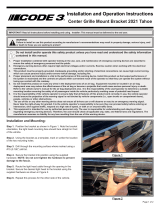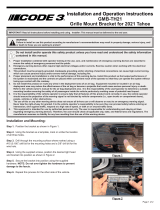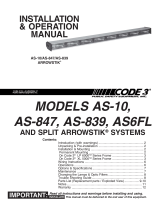Page is loading ...

920-0546-00 Rev. A
Page 1 of 8
Installation & Operation Manual
CommandStik™ With
MR6MC Light Heads
Interior Lighting System
Installation and Operation Instructions
CD3766 Directional LED
MR6MC COMMANDSTIK
UNIVERSAL SUV VERSION
MR6MC COMMANDSTIK 2011+ DODGE
CHARGER VERSION
Introduction: CommandStik With MR6MC
Light Heads
The CommandStik with MR6MC Multi Color Tech-
nology is an interior lighting system that ts in the
rear deck area. The CommandStik has room for up
to six MR6MC Multi Color light heads.
CONTENTS:
Introduction................................................................1
Product Specications................................................1
Unpacking & Pre-Installation......................................2
Installation & Mounting - Universal............................2
Installation & Mounting - 2011+ Dodge Charger.....3-4
Wiring Instructions......................................................5
Flash Pattern Selection..............................................6
Troubleshooting..........................................................7
Exploded View-Parts List...........................................7
Warranty.....................................................................8
Product Specications:
MR6MC Light Head Options: Red/Amber, Blue/Amber
Size Full Unit:------27.50” long X 1.25” tall X 3.50” deep------------------------------------------------------------------------Weight: 4.5 lbs
Input Voltage: ---------------------------------------------------------------------------------------------------------------------------------------12VDC
Input Current: Startup Current-------------------------------------------------------------------------------------------------------------0.007 Amps
Current @ Power-----------------------------------------------------------------------------------------------------------------------------0.005 Amps
Max Current----------(6) Light Hd ---------------------------------------------------------------------------------------------------------11.30 Amps
Mounting Hardware - All mounting hardware is packed in a small bag inside the main carton. There are two
brackets used to mount the CommandStik to the vehicle. These are discussed in detail later.

920-0546-00 Rev. A
Page 2 of 8
IMPORTANT! Read all instructions before installing and using. Installer: This manual must be delivered to the end user.
1. Proper installation combined with operator training in the use, care, and maintenance of emergency warning devices are essential to
ensure the safety of emergency personnel and the public.
2. Emergency warning devices often require high electrical voltages and/or currents. Exercise caution when working with live electrical
connections.
3. This product must be properly grounded. Inadequate grounding and/or shorting of electrical connections can cause high current arcing,
which can cause personal injury and/or severe vehicle damage, including re.
4. Proper placement and installation is vital to the performance of this warning device. Install this product so that output performance of the
system is maximized and the controls are placed within convenient reach of the operator so that s/he can operate the system without losing
eye contact with the roadway.
5. It is the responsibility of the vehicle operator to ensure daily that all features of this product work correctly. In use, the vehicle operator
should ensure the projection of the warning signal is not blocked by vehicle components (i.e., open trunks or compartment doors), people,
vehicles or other obstructions.
6. The use of this or any other warning device does not ensure all drivers can or will observe or react to an emergency warning signal. Never
take the right-of-way for granted. It is your responsibility to be sure you can proceed safely before entering an intersection, drive against
trafc, respond at a high rate of speed, or walk on or around trafc lanes.
7. This equipment is intended for use by authorized personnel only. The user is responsible for understanding and obeying all laws regarding
emergency warning devices. Therefore, the user should check all applicable city, state, and federal laws and regulations. The manufacturer
assumes no liability for any loss resulting from the use of this warning device.
Do not install and/or operate this safety product unless you have read and understand the safety information
contained in this manual.
Unpacking & Pre-installation
Carefully remove the CommandStik and place it on a at surface, taking care not to scratch the lenses or damage the cable
coming out of the unit. Examine the unit for transit damage, broken lamps, etc. Report any damage to the carrier and keep
the shipping carton.
Standard units are built to operate on 12 volt D.C. negative ground (earth) vehicles. If you have an electrical system other
than 12 volt D.C. negative ground (earth), and have not ordered a specially wired light bar, contact the factory for instructions.
Test the unit before installation. To test, touch the black wire to the ground (earth) and the other wires to +12 volts D.C., in ac-
cordance with the instructions attached to the cable (an automotive battery is preferable for this test). A battery charger may
be used, but note that some electronic options may not operate normally when powered by a battery charger. If problems
occur at this point, contact the factory. Note: Before beginning the installation process, be absolutely certain that the
Light Bar functions as desired (See page 4 & 5 for options)!
Installation Instructions: Universal Version
Step 1 Assemble the mounting brackets to the CommandStik with the the supplied 1/4"-20 screws and internal tooth
lock washers and tighten the screws nger tight (see page 7 exploded view for orientation).
Step 2 Using the CommandStik assembly as a template, locate the CommandStik in the desired location for the light
bar in the vehicles rear deck area and mark the location of the customer supplied carriage bolts using the square holes
in the CommandStik 90 degree mounting brackets. Note: The square holes in the CommandStik's 90 degree mounting
brackets are sized for 1/4-20 carriage bolts.
Step 3 Drill the required mounting holes through the vehicles fabric and sheet metal to provide a hole for the customer
supplied mounting bolts. Note: in many cases some sort of spacer will be required between the vehicle's fabric
and it's sheet metal to keep the fabric from collapsing as you tighten the hardware. The spacer should be made
out of a suitable plastic or metal for safety.
Step 4 Install the customer supplied carriage bolts, washers and lock washers through the square holes in the Com-
mandStik's 90 degree mounting brackets and through the holes in the vehicle's rear deck fabric and sheet metal and
tighten all fasteners securely.
Caution: Drilling into the housing of the light bar could damage wiring or other internal components.
WARNING! Failure to install or use this product according to manufacturers recommendations may result in
property damage, serious injury, and/or death to those you are seeking to protect!
WARNING! When drilling into any vehicle surface, make sure that the area is free from any electrical
wires, fuel lines, sensors, vehicle upholstery,etc. that could be damaged.

920-0546-00 Rev. A
Page 3 of 8
Installation Instructions: 2011+ Dodge Charger Version
Step 1 Fasten the CommandStik Mounting Brackets with the the supplied 1/4"-20 X 3/8” long screws, 1/4” internal tooth
lock washers, & 1/4” at washers and tighten the screws nger tight (see Figure 1 below for bracket orientation). Make sure
you thread the screws into the inner mounting holes in the brackets as shown.
Step 2 Remove the (2) outer child restraint covers shown in Figure 2 on page 4. Position the CommandStik in the rear deck
of the vehicle with the mounting brackets positioned in the child restraint pockets and align the threaded holes in the mount-
ing brackets with the existing holes in the vehicle. See Figure 3 on page 4.
Step 3 Remove the fabric cover from inside the vehicle’s trunk, thread a supplied 1/4”-20 X 5/8” Phillips Pan Head Machine
Screw with a 1/4” internal tooth lock washer, & 1/4” at washer through the existing hole in the child restraint area & into the
threaded holes in the Pemserts in each of the CommandStik Mounting Brackets (see Page 5 Figure 4). Leave the screws
just slightly loose. Note: It is extremely helpful to have an assistant line up and hold the CommandStik’s Mounting
Brackets in location to prevent movement while you are threading the screws into the holes.
Step 4 Center the CommandStik in the rear deck area and tighten all of the screws. Replace the fabric cover inside the
vehicle’s trunk & snap the round plastic plugs into the holes in the top of the CommandStik to plug the holes.
Caution: Drilling into the housing of the light bar could damage wiring or other internal components.
Step 5 To replace the plastic child restraint covers you will have to trim the covers to clear the CommandStik’s Mounting
Brackets then re install the covers.
MOUNT TO
INNER MOUNTING
BRACKET HOLES
UNDER SIDE VIEW
PLASTIC
HOLE PLUG
1/4"-20 X 3/8" LONG
PHILLIPS PAN
HEAD SCREW
1/4" INTERNAL
TOOTH LOCK
WASHER
1/4" FLAT
WASHER
TOP SIDE VIEW
1/4"-20 X 5/8" LONG
PHILLIPS PAN
HEAD SCREW
FIGURE 1

920-0546-00 Rev. A
Page 4 of 8
FIGURE 2 FIGURE 3 FIGURE 4
Installation Instructions: 2011+ Dodge Charger Version Continued.

920-0546-00 Rev. A
Page 5 of 8
WIRING DIAGRAM-MR6 MULTI COLOR COMMANDSTIK
POWER/GROUND
RED WIRE------------------------ POWER +12VDC
PROTECT WITH 20 AMP FUSE
BLACK WIRE-------------------- GROUND WIRE
FLASH PATTERN CONTROL WIRES
CONNECT WIRES TO +12VDC TO PERFORM THE FUNCTIONS LISTED BELOW
GREEN WIRE-------------------- FOR SUV'S - ARROWSTIK RIGHT, FOR SEDAN'S - ARROWSTIK LEFT
WHITE WIRE--------------------- FOR SUV'S - ARROWSTIK LEFT, FOR SEDAN'S - ARROWSTIK RIGHT
GREEN + WHITE------ ---------ARROWSTIK CENTER OUT
PURPLE WIRE------------------ ARROWSTIK FLASH
LIGHT BLUE WIRE----------- SCENE LIGHTS
BLUE WIRE---------------------- N/A
YELLOW / BLACK WIRE --- SEQUENCE SELECT
YELLOW WIRE----------------- RATE SELECT
BROWN WIRE------------------ LEVEL 1 FLASH
ORANGE WIRE----------------- LEVEL 2 FLASH
LIGHT BAR CABLE
IMPORTANT WIRING NOTES:
1. Larger wires and tight connections will provide longer service life for components. For high current wires it is highly recom-
mended that terminal blocks or soldered connections be used with heat shrink tubing to protect the connections.
2. Route wiring using grommets and sealant when passing through compartment walls. Minimize the number of splices to
reduce voltage drop. NOTE: High ambient temperatures (e.g. under hood) will signicantly reduce the current carrying
capacity of wires, fuses,and circuit breakers. All wiring should conform to the minimum wire size and other recommendations
of the manufacturer and be protected from moving parts and hot surfaces. Looms, grommets, cable ties, and similar installation
hardware should be used to anchor and protect all wiring.
3. Fuses or circuit breakers should be located as close to the power takeoff points as possible and properly sized to protect the
wiring and devices.
4. Particular attention should be paid to the location and method of making electrical connections and splices to protect these
points from corrosion and loss of conductivity.
5. Ground terminations should only be made to substantial chassis components, preferably directly to the vehicle battery.
6. Circuit breakers are very sensitive to high temperatures and will “false trip” when mounted in hot environments or operated
close to their capacity.
Important: This unit is a safety device, and it must be connected to its own separate, fused power point to assure
its continued operation should any other electrical accessory fail.
Wiring Instructions:
It is advisable to leave an extra loop of cable when installing the light bar to allow for future changes or reinstallations.
Connect the black lead to a solid frame ground (earth), preferably the (-) or ground (earth) side of the battery, and the
power wire to the +12V terminal of the battery. Connect the remaining wires as shown on below.

920-0546-00 Rev. A
Page 6 of 8
WARNING! This product contains high intensity LED devices. To prevent eye damage, DO NOT stare into the light beam at
close range.
Flash Pattern Instructions: MR6MC CommandStik Multi Color Units
Light Head Flash Rates - Multi Color
Double Flash-75 - LEVEL - 2 DEFAULT
Triple Flash-75
Quad Flash-75
Quint Flash-75
Double Flash-150
Triple Flash-150 - LEVEL - 1 DEFAULT
Quad Flash-150
Quint Flash-150
Triple Pop Flash-150
Quad Pop Flash-150
Single Flash-375
Cycle Rates
Light Head Flash Sequences - Multi Color
LEFT / RIGHT PRIMARY & SECONDARY
(DEFAULT) PRIMARY ONLY - LEVEL - 1 DEFAULT
SECONDARY ONLY
PRIMARY W / SECONDARY POPS
PRIMARY W / SECONDARY RANDOM
EVEN / ODD PRIMARY & SECONDARY
PRIMARY ONLY - LEVEL - 2 DEFAULT
SECONDARY ONLY
PRIMARY W / SECONDARY POPS
PRIMARY W / SECONDARY RANDOM
RANDOM PRIMARY & SECONDARY
PRIMARY ONLY
SECONDARY ONLY
PRIMARY W / SECONDARY POPS
PRIMARY W / SECONDARY RANDOM
CYCLE SEQUENCE PRIMARY & SECONDARY
RANDOM PRIMARY ONLY
SECONDARY ONLY
PRIMARY W / SECONDARY POPS
PRIMARY W / SECONDARY RANDOM
ALL ON PRIMARY & SECONDARY
RANDOM
SWEEP SECONDARY ONLY
LEFT / RIGHT
NULL ALL LIGHT HEADS OFF
INSTALLER NOTE:
FLASH RATE + FLASH SEQUENCE = FLASH PATTERN
Scene Steady ArrowStik Pattern ArrowStik Speed
All Primary Build - DEFAULT 0
All Secondary - DEFAULT Build 3 Flash 1
Travel 3 Flash 2
Build / Collapse 3
ArrowStik Overrides All Other functions.
Scene Steady Overrides L1 & L2 Flashing.

920-0546-00 Rev. A
Page 7 of 8
Troubleshooting
All CommandStik Products are thoroughly tested prior to shipment. However, should you encounter a problem during
installation or during the life of the product, follow the guide below for information on repair and troubleshooting. Additional
information may be obtained from the factory technical help line at 314-996-2800. Follow the guide below for information on
repair and troubleshooting.
TROUBLESHOOTING GUIDE
PROBLEM QUESTIONS POSSIBLE CAUSE SOLUTION
MR6MC Light A. Bad power/ground Connection A. Fix connection.
Head Module N/A
not operating B. Defective module. B. Replace module
when powered.
Parts List
Reference Number Part Description Part Number Qty
1 Outer Panel T15552 1
2 Chassis 220-0906-00 2
3 AS-10 Universal Mounting Bracket S50008 2
4 MR6MC Module *Contact Code 3, Inc for P/N Up to 6
5 .625 Diameter Cap T05431 2
6 Circuit Board Assembly 160-0494-00 1
7 Internal tooth starwasher .250 T06935 4
8 1/4-20 x 3/8" Phil Pan Hd, Black Zinc, Stl T89965 4
9 .750 Diameter Cap T00232 2
10 Dedicated Mtg Bkt 2011+ Dodge Charger 220-0859-00 2
11 #6-32 X 3/4” Lg Phil Pan Head Screw SS T57024 4
1
9
2
3
4
5
5
6
7
8
10
11

920-0546-00 Rev. A
Page 8 of 8
10986 North Warson Road
St. Louis, MO 63114
Technical Service:
(314) 996-2800
www.code3esg.com
A Division of ESG | www.eccogroup.com
Manufacturer Limited Warranty Policy:
Manufacturer warrants that on the date of purchase this product will conform to Manufacturer
’s specications for this product (which are available
from the Manufacturer upon request). This Limited Warranty extends for Sixty (60) months from the date of purchase.
DAMAGE TO PARTS OR PRODUCTS RESULTING FROM TAMPERING, ACCIDENT, ABUSE, MISUSE, NEGLIGENCE, UNAPPROVED MODIFICA-
TIONS, FIRE OR OTHER HAZARD; IMPROPER INSTALLATION OR OPERATION; OR NOT BEING MAINTAINED IN ACCORDANCE WITH THE MAIN-
TENANCE PROCEDURES SET FORTH IN MANUFACTURER’S INSTALLATION AND OPERATING INSTRUCTIONS VOIDS THIS LIMITED WARRANTY.
Exclusion of Other Warranties:
MANUFACTURER MAKES NO OTHER WARRANTIES, EXPRESS OR IMPLIED. THE IMPLIED WARRANTIES FOR MERCHANTABILITY, QUALITY OR
FITNESS FOR A PARTICULAR PURPOSE, OR ARISING FROM A COURSE OF DEALING, USAGE OR TRADE PRACTICE ARE HEREBY EXCLUDED
AND SHALL NOT APPLY TO THE PRODUCT AND ARE HEREBY DISCLAIMED, EXCEPT TO THE EXTENT PROHIBITED BY APPLICABLE LAW.
ORAL STATEMENTS OR REPRESENTATIONS ABOUT THE PRODUCT DO NOT CONSTITUTE WARRANTIES.
Remedies and Limitation of Liability:
MANUFACTURER’S SOLE LIABILITY AND BUYER’S EXCLUSIVE REMEDY IN CONTRACT, TORT (INCLUDING NEGLIGENCE), OR UNDER ANY
OTHER THEORY AGAINST MANUFACTURER REGARDING THE PRODUCT AND ITS USE SHALL BE, AT MANUFACTURER’S DISCRETION, THE
REPLACEMENT OR REPAIR OF THE PRODUCT, OR THE REFUND OF THE PURCHASE PRICE PAID BY BUYER FOR NON-CONFORMING PROD-
UCT. IN NO EVENT SHALL MANUFACTURER’S LIABILITY ARISING OUT OF THIS LIMITED WARRANTY OR ANY OTHER CLAIM RELATED TO THE
MANUFACTURER’S PRODUCTS EXCEED THE AMOUNT PAID FOR THE PRODUCT BY BUYER AT THE TIME OF THE ORIGINAL PURCHASE. IN NO
EVENT SHALL MANUFACTURER BE LIABLE FOR LOST PROFITS, THE COST OF SUBSTITUTE EQUIPMENT OR LABOR, PROPERTY DAMAGE, OR
OTHER SPECIAL, CONSEQUENTIAL, OR INCIDENTAL DAMAGES BASED UPON ANY CLAIM FOR BREACH OF CONTRACT, IMPROPER INSTAL-
LATION, NEGLIGENCE, OR OTHER CLAIM, EVEN IF MANUFACTURER OR A MANUFACTURER’S REPRESENTATIVE HAS BEEN ADVISED OF THE
POSSIBILITY OF SUCH DAMAGES. MANUFACTURER SHALL HAVE NO FURTHER OBLIGATION OR LIABILITY WITH RESPECT TO THE PRODUCT
OR ITS SALE, OPERATION AND USE, AND MANUFACTURER NEITHER ASSUMES NOR AUTHORIZES THE ASSUMPTION OF ANY OTHER OBLIGA-
TION OR LIABILITY IN CONNECTION WITH SUCH PRODUCT.
This Limited Warranty denes specic legal rights. You may have other legal rights which vary from jurisdiction to jurisdiction. Some jurisdictions
do not allow the exclusion or limitation of incidental or consequential damages.
Product Returns:
If a product must be returned for repair or replacement*, please contact our factory to obtain a Return Goods Authorization Number (RGA number)
before you ship the product to Code 3®, Inc. Write the RGA number clearly on the package near the mailing label. Be sure you use sufcient packing
materials to avoid damage to the product being returned while in transit.
*Code 3®, Inc. reserves the right to repair or replace at its discretion. Code 3®, Inc. assumes no responsibility or liability for expenses incurred for the removal and /or reinstallation of products requiring service and/or repair.; nor for the packaging, handling,
and shipping: nor for the handling of products returned to sender after the service has been rendered.
/











